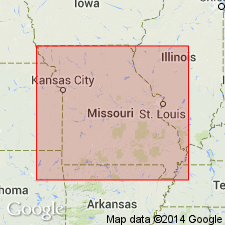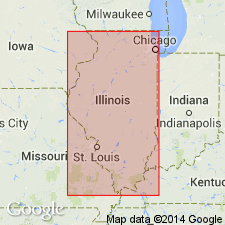
- Usage in publication:
-
- Glen Park limestone member
- Modifications:
-
- Original reference
- Dominant lithology:
-
- Limestone
- AAPG geologic province:
-
- Illinois basin
- Ozark uplift
Summary:
Pg. 110. Glen Park limestone member of Sulphur Springs formation. Oolitic limestone, 5 feet thick, forming middle member of Sulphur Springs formation. Overlain by Bushberg sandstone member and underlain by 0 to 15 feet of shale forming basal part of Sulphur Springs formation. [Age is Early Mississippian (Kinderhook).]
[Named from exposures at Glen Park Station, Jefferson Co., central eastern MO.]
Source: US geologic names lexicon (USGS Bull. 896, p. 829).

- Usage in publication:
-
- Glen Park formation*
- Modifications:
-
- Overview
- AAPG geologic province:
-
- Illinois basin
- Ozark uplift
Summary:
Glen Park formation of Kinderhook group. See under Sulphur Springs formation. The 5 feet of oolitic limestone to which Ulrich applied name Glen Park appears to be only minor part of the formation later called Glen Park limestone by Moore and others. Age is Mississippian.
Named from exposures at Glen Park Station, Jefferson Co., central eastern MO.
Source: US geologic names lexicon (USGS Bull. 896, p. 829).

- Usage in publication:
-
- "Glen Park" Formation
- Modifications:
-
- Overview
- Age modified
- AAPG geologic province:
-
- Illinois basin
Summary:
Studies of conodonts indicate that Glen Park Formation of St. Louis area, MO and Glen Park of Hamburg area in IL are not the same age. Type Glen park is Devonian and Hamburg strata are Mississippian, but the name "Glen Park" has been retained pending introduction of a new name. "Glen Park" is exposed in and near Mississippi River bluffs in Calhoun, Pike, and Jersey Cos. and in lower Illinois River valley in Calhoun and Jersey Cos. Restricted to western IL. Much of the brown shale included in "Glen Park" by Workman and Gillette (1956) is now assigned to Hannibal Shale. Lithology of "Glen Park" varies considerably and may be almost any combination of sandy, silty, brown or buff limestone; buff siltstone, silty shale; oolitic limestone; limestone conglomerate; or thin sandstone beds. Limestone contains beds of dolomitic siltstone bearing TASMANITES and lenses of highly fossiliferous, white to buff, conglomeratic, oolitic, cross-bedded limestone. Unconformably overlies Louisiana Limestone, or Saverton Shale where Louisiana is absent. However, no unconformity is generally recognized where "Glen Park" is absent.
Source: GNU records (USGS DDS-6; Reston GNULEX).
For more information, please contact Nancy Stamm, Geologic Names Committee Secretary.
Asterisk (*) indicates published by U.S. Geological Survey authors.
"No current usage" (†) implies that a name has been abandoned or has fallen into disuse. Former usage and, if known, replacement name given in parentheses ( ).
Slash (/) indicates name conflicts with nomenclatural guidelines (CSN, 1933; ACSN, 1961, 1970; NACSN, 1983, 2005, 2021). May be explained within brackets ([ ]).

